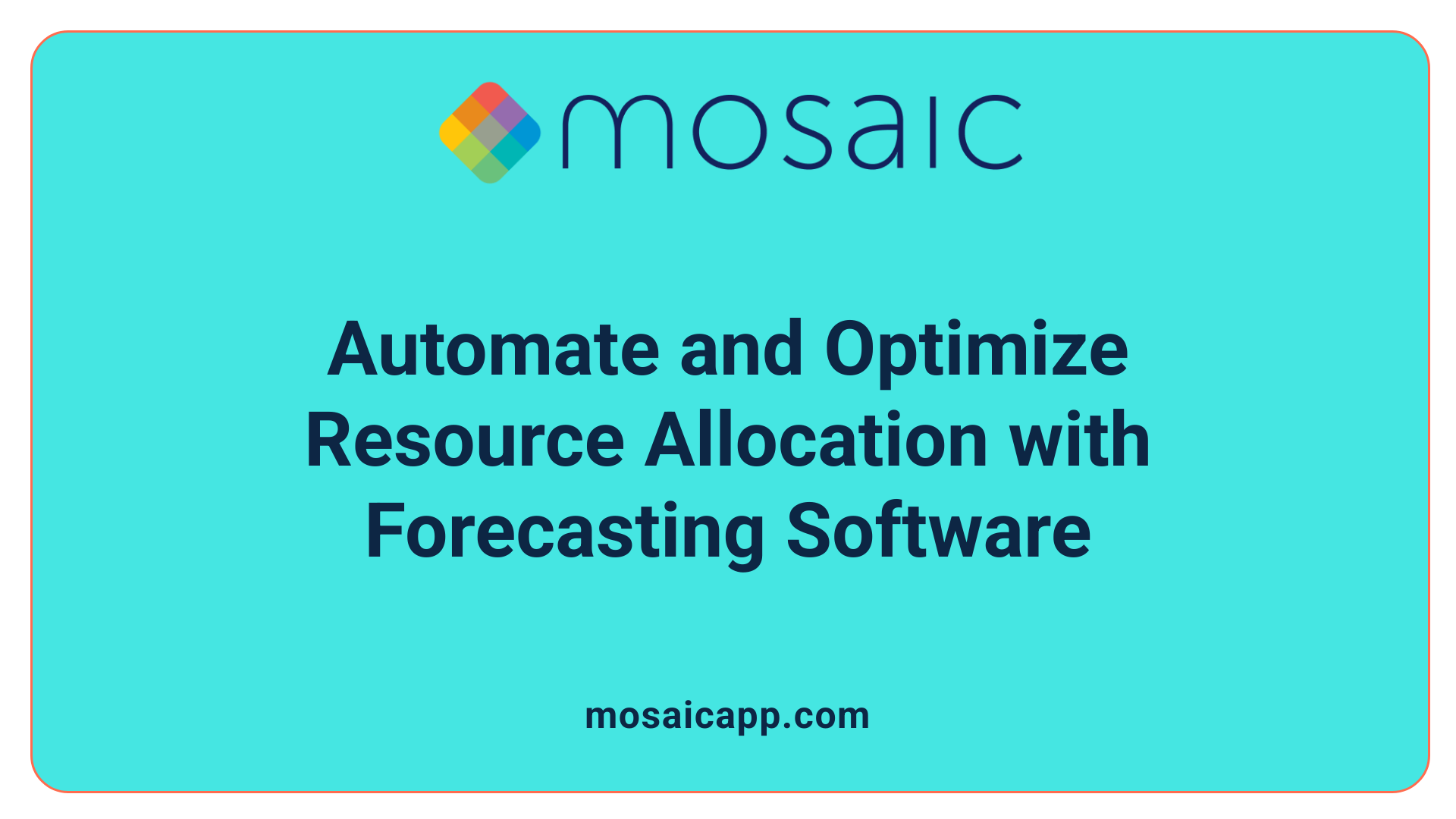The Strategic Edge of Smarter Forecasting
In today’s competitive market landscape, manufacturing and project management firms face increasing pressure to boost client satisfaction while maintaining healthy profit margins. One of the most effective but often underleveraged tools to achieve this balance is smarter forecasting—leveraging detailed production and resource forecasting methods to align supply with demand precisely. This article will explore how businesses can harness forecasting’s full potential to improve operational efficiency, reduce waste, enhance client experience, and ultimately increase profitability.
Understanding Production Forecasting: The Backbone of Manufacturing Efficiency

What is production forecasting and how is it conducted?
Production forecasting is the process of predicting future manufacturing output to better align operations with expected demand. It involves analyzing historical production data, market trends, and customer demand to provide insights that inform decision-making. By anticipating future needs, businesses can optimize inventory levels, schedule staffing appropriately, and plan production efficiently.
Data sources for forecasting
To generate accurate forecasts, companies rely on several types of data. These include historical sales patterns, order history, seasonal demand fluctuations, and market insights. Integrating these data points helps create a comprehensive view of expected production needs.
The ongoing nature of forecasting
Production forecasting is not a one-time task but a continuous process. It requires constant adjustment as market conditions fluctuate and internal changes occur. This adaptability ensures that forecasts remain relevant and that operations can respond flexibly.
Departments involved in forecasting
Accurate production forecasts are the result of collaboration across multiple departments. Production management offers insights into manufacturing capabilities, procurement shares supply considerations, while sales and marketing provide demand signals. Demand forecasting specialists analyze data trends, and finance evaluates the financial impact. This multidisciplinary approach enhances forecast reliability and operational alignment.
Quantitative Forecasting Methods: Harnessing Data for Accurate Predictions
Which quantitative methods are commonly applied in production forecasting?
Quantitative forecasting methods such as Time Series Analysis, Exponential Smoothing, and ARIMA are essential tools in production forecasting. These methods analyze historical data patterns, sales trends, and seasonal fluctuations to create reliable predictions.
Time Series Analysis
This method examines data points collected or recorded at specific time intervals. It identifies trends, seasonal effects, and cyclical patterns to forecast future production output. Time Series Analysis helps manufacturers understand how demand changes over time, assisting in aligning inventory and staffing accordingly.
Exponential Smoothing
Exponential Smoothing assigns exponentially decreasing weights to older observations, giving more emphasis to recent data. This technique is particularly effective for capturing shifts in demand, as it quickly adapts to changes, improving the responsiveness of production schedules.
ARIMA (AutoRegressive Integrated Moving Average)
ARIMA is a sophisticated time series forecasting method that models different aspects of the data, including trends, cycles, and noise. It is highly effective in dealing with non-stationary data and producing accurate predictions for complex, real-world manufacturing environments.
The Use of Quantitative Methods
By employing these quantitative approaches, manufacturers can base their forecasts on solid, numerical evidence rather than guesses. This results in more precise production planning, reduced waste and stockouts, and improved alignment across departments such as procurement, sales, and finance. Moreover, quantitative forecasting supports ongoing adjustments based on real-time data, increasing agility and competitiveness in dynamic markets.
Qualitative Forecasting Approaches: Integrating Expert Insight and Market Intelligence

How do qualitative methods complement quantitative forecasting?
Qualitative forecasting approaches, such as the Delphi Method, Market Research, and Sales Force Composite, play a vital role in enriching production forecasting. These approaches primarily gather expert opinions, customer feedback, and broader market insights.
For example, the Delphi Method involves structured expert consultation to reach consensus forecasts, which helps reduce bias and leverage collective knowledge. Market Research gathers information on consumer preferences, competitive landscape, and emerging trends, providing insights that historical numerical data might not reveal. The Sales Force Composite collects feedback from sales teams who understand customer needs and real-time market dynamics.
These qualitative methods are especially useful for new products or entering new markets where historical sales data is limited or nonexistent. They supplement quantitative techniques by incorporating anticipated changes, customer attitudes, and potential market disruptions. This combined use enables manufacturers to create more accurate predictions and effective production plans.
By integrating these qualitative insights with quantitative data, businesses can attain a balanced forecasting perspective, improving responsiveness and decision-making in uncertain or evolving environments.
Linking Accurate Production Forecasting to Client Satisfaction and Business Margins
How does production forecasting impact client satisfaction and profit margins?
Accurate production forecasting plays a crucial role in enhancing both client satisfaction and the company's profit margins. By predicting future demand, businesses can effectively reduce waste through improved inventory management. This means fewer surplus materials and lower storage costs.
At the same time, forecasting helps prevent stockouts by ensuring that production aligns precisely with customer demand. This alignment avoids delays or missed orders, resulting in timely deliveries that meet client expectations consistently.
Improved forecasting also significantly boosts operational efficiency. Streamlined production schedules reduce downtime and optimize the use of resources, which allows companies to operate more cost-effectively.
The cumulative effect of reducing waste and stockouts, alongside heightened efficiency, directly contributes to enhanced customer satisfaction. Satisfied customers are more likely to remain loyal and even increase their repeat business.
From a financial standpoint, efficient production means lower operational costs and minimized losses from unsold inventory. These savings translate into increased profit margins, allowing companies to reinvest in growth and innovation.
In summary, accurate production forecasting creates a win-win situation by improving customer experiences through reliable product availability and positively impacting the bottom line through cost savings and better resource utilization.
Resource Forecasting: Anticipating and Aligning Workforce and Materials to Project Needs
What is resource forecasting and why is it critical in project management?
Resource forecasting predicts future resource demands—including people, finances, and materials—by evaluating data like sales pipelines, timesheets, hiring schedules, and employee availability. This forecasting approach helps project managers allocate resources effectively, meet project objectives, and prevent delays. By balancing workloads and aligning tasks with employee skills, it also reduces burnout and stress, contributing to higher morale and productivity.
What data inputs are essential for effective resource forecasting?
Resource forecasting relies on both demand and supply data. Demand data includes sales pipeline figures, engagement metrics, historical sales trends, and backlogs that inform future project needs. Supply data focuses on internal resources such as current staffing schedules, hiring timelines, ramp-up periods, and attrition rates. Together, these inputs allow for an accurate estimate of what resources will be required and when.
How does resource forecasting help match resources to project requirements?
By assessing existing team capacity alongside future project demands, resource forecasting helps assign tasks best suited to employees' skills and availability. Forecasts take into account constraints such as skills gaps or limited availability to optimize resource allocation. This ensures projects progress smoothly with adequately skilled personnel and helps avoid resource conflicts.
How does resource forecasting help avoid overstaffing and understaffing?
Proper forecasting prevents scenarios where too many or too few employees are assigned to projects, which can lead to increased costs, employee stress, or project delays. Balanced workloads avoid burnout, boost employee satisfaction, and reduce turnover. This strategic staffing approach also helps organizations manage resources dynamically as project needs and team availability evolve over time.
| Aspect | Description | Impact on Project Management |
|---|---|---|
| Definition | Prediction of future resource needs including workforce and materials | Enables planning and avoids delays |
| Data Inputs | Sales pipelines, timesheets, hiring timelines, attrition details | Provides accuracy in matching supply and demand |
| Matching Resources | Aligning skills and availability with project tasks | Optimizes team productivity and project success |
| Avoiding Over/Understaffing | Forecasting based on capacity and demand | Reduces burnout, turnover, and cost inefficiencies |
Forecasting Software: Automating and Enhancing Resource Allocation Accuracy

How do forecasting software tools improve resource management?
Forecasting software tools transform traditional resource planning by automating the collection and analysis of data. This automation eliminates the reliance on manual data consolidation, which often causes delays and errors. By providing real-time tracking, these tools allow project managers and teams to see up-to-date resource availability, allocation, and usage.
One significant benefit is the improvement in decision-making. With accurate, real-time data, organizations can allocate resources more efficiently, balance workloads, and anticipate future needs with greater precision. This proactive approach reduces the risk of overstaffing or understaffing, prevents project delays, and helps avoid employee burnout.
The role of automation and real-time tracking
Automation streamlines repetitive forecasting tasks such as updating schedules, calculating resource demand, and monitoring progress. Real-time tracking ensures that any changes—like shifts in project timelines or employee availability—are immediately reflected in the forecast. This dynamic capability enables rapid adjustments to resource plans, keeping projects on track despite unforeseen challenges.
Case study: Logicalis and Kantata software
Logicalis' experience with Kantata’s resource forecasting software perfectly illustrates these benefits. Prior to implementing the tool, their resource planning process took days and was prone to inaccuracies due to manual data handling. With Kantata, Logicalis cut planning time dramatically from days to hours.
This software facilitated seamless data integration, enhanced accuracy, and improved collaboration between departments. The result was a more agile resource management system that supported timely project deliveries and optimized workforce utilization.
| Feature | Benefit | Impact Example |
|---|---|---|
| Automation | Reduces manual work, minimizes errors | Logicalis reduced planning time dramatically |
| Real-time tracking | Enables instant updates and adjustments | Projects stay on schedule despite changes |
| Data-driven decision-making | Facilitates proactive resource allocation | Balanced workloads, avoiding burnout |
| Enhanced communication | Improves coordination across teams | Better teamwork and project outcomes |
Overall, forecasting software empowers organizations to manage resources more effectively, leading to improved project success and employee satisfaction.
Balancing Workloads and Skills Through Forecasting to Boost Productivity and Morale
Assigning Work Suited to Employee Skills
Effective resource forecasting enables managers to match tasks with employees’ specific skills and expertise. By understanding each team member's capabilities, businesses ensure that workers handle assignments fitting their strengths, which promotes efficiency and quality.
Reducing Burnout
Forecasting helps avoid the pitfalls of overstaffing and understaffing by providing a balanced workload. When workloads are equitably distributed, employees are less likely to experience excessive stress and burnout. This reduces turnover and keeps teams resilient and energetic.
Increasing Job Satisfaction and Innovation
With balanced workloads and appropriate task assignments, employee morale improves significantly. Job satisfaction rises as workers feel valued and capable in their roles. A positive workplace encourages creativity and collaboration, fueling innovation that benefits project success and overall organizational health.
How Does Forecasting Contribute to Employee Productivity and Morale?
By aligning tasks to skills and maintaining workload balance, forecasting helps prevent resource conflicts and employee fatigue. This leads to higher productivity and a motivated workforce ready to tackle challenges through collective innovation. Forecasting thus acts as a vital tool to nurture a capable, satisfied, and innovative team ready to meet project goals efficiently.
Challenges in Forecasting: Addressing Data and Process Limitations
What are common challenges organizations face in forecasting?
Effective forecasting is crucial but fraught with challenges that can undermine accuracy and utility. A primary obstacle is data access issues—organizations often struggle to gather comprehensive and timely data needed for reliable forecasts. Without seamless access to real-time sales, production, and resource data, forecasting becomes guesswork.
Another significant barrier is the reliance on manual data consolidation. Many companies still depend heavily on spreadsheets for data aggregation, which is time-consuming and prone to errors. Manual processes limit forecasting to short-term views and decrease responsiveness.
Compounding these technical difficulties is a widespread lack of trust in forecast data. Data inconsistencies and fragmented reporting reduce confidence among stakeholders, making it harder to base decisions on forecasts.
Organizational silos further obstruct the forecasting process. Departments such as production, sales, procurement, and finance often operate independently, hindering the flow of information needed for integrated and accurate predictions.
Lastly, the heavy dependence on spreadsheets restricts the scalability and sophistication of forecasting techniques. Spreadsheets typically cannot handle complex models or automation, leading to inefficiencies and delays.
Addressing these challenges requires deploying integrated forecasting tools, enhancing data transparency, and fostering cross-department collaboration to improve forecast reliability and operational decision-making.
Steps to Build an Effective Forecast: A Structured Approach
What are the key steps in developing an accurate production or resource forecast?
Building an effective forecast begins with clearly defining the project scope to understand the objectives and deliverables involved.
Next, it is crucial to identify all relevant resource categories, including personnel, equipment, and materials, to ensure comprehensive planning.
Estimating resource requirements involves analyzing historical data and project needs, while assessing availability considers factors like employee capacity, skill sets, and hiring timelines.
Considering constraints such as budget limits, project deadlines, and potential attrition helps manage risks and avoids overcommitment.
Forecasting demand uses data-driven insights from sales pipelines, market trends, and seasonal patterns to anticipate future needs accurately.
Resource allocation then matches requirements with availability, enabling balanced workloads and efficient scheduling.
Finally, continuous monitoring and refining of the forecast are vital to respond quickly to unforeseen changes or shifting priorities, maintaining project alignment and timely delivery.
This structured approach ensures forecasts remain accurate and actionable, fostering proactive decision-making and optimal resource utilization.
Centralizing and Integrating Forecasting to Overcome Organizational Silos

How does centralizing resource management improve forecasting outcomes?
Centralizing resource management plays a crucial role in breaking down organizational silos that often hinder effective forecasting. When data is consolidated across departments such as production management, procurement, sales, and finance, it ensures that all stakeholders operate with accurate, up-to-date information. This eliminates discrepancies caused by isolated data pools and reduces errors from manual consolidation.
Importance of centralizing resource management
A centralized system streamlines forecasting processes by providing a single source of truth. This integration enhances the accuracy of resource and production forecasts, which are essential to aligning inventory, staffing, and scheduling with actual demand. It also enables better assessment of current team capacity, identification of resource gaps, and informed allocation decisions.
Role of technology integration
Integrating advanced resource forecasting software automates data collection and real-time tracking, reducing the workload and potential human error. Automation tools facilitate seamless updates to sales pipelines, timesheets, and resource schedules, allowing project managers to respond swiftly to changing conditions without delays.
Enhancing communication across teams
Technology-powered centralization fosters transparent communication among departments, aiding collaboration and the sharing of qualitative insights from sales and marketing alongside quantitative data. This collaboration leads to cohesive production plans and agile adjustments as market trends and project requirements evolve.
Ultimately, centralizing resource management combined with robust technology integration forms the backbone of an effective forecasting strategy. It enables faster, coordinated decision-making aligned with strategic goals, proactively mitigating risks such as overstaffing, stockouts, or project delays.
The Business Case: How Smarter Forecasting Drives Competitive Advantage

Why is smarter forecasting essential for competitive advantage?
Smarter forecasting acts as the foundation for a competitive manufacturing business by enabling proactive resource allocation. It helps companies anticipate future resource needs, ensuring that staffing, materials, and other assets are available precisely when required. This proactive approach reduces instances of costly delays and overhead from underutilized resources.
Moreover, improved utilization of resources means organizations maximize output without unnecessary waste. By aligning production capacities with actual demand, businesses can achieve better cost control and avoid surplus inventory.
Risk management is another critical benefit. Accurate forecasting allows companies to foresee potential disruptions such as sudden demand spikes or supply chain bottlenecks. Early identification of these risks facilitates contingency planning, minimizing negative impacts on operations.
Forward-looking planning is enhanced by integrating historical data with current market trends, enabling firms to stay ahead of changes and prepare for future scenarios. This strategic outlook ensures smoother project delivery and operational continuity.
Finally, smarter forecasting heightens customer responsiveness by aligning production schedules with real-time demand fluctuations. This agility leads to improved customer satisfaction and loyalty, as clients receive products timely and reliably.
Together, these advantages build a robust operational framework that boosts client satisfaction while protecting profit margins and sustaining a competitive edge in the manufacturing sector.
Forecasting: The Strategic Pillar of Client Satisfaction and Profitability
Smarter forecasting transcends its traditional role as a planning tool, emerging as a strategic pillar that profoundly influences client satisfaction and profit margins. By integrating comprehensive production and resource forecasting—utilizing both quantitative and qualitative methods, supported by modern software—organizations can proactively manage supply and demand, optimize resource allocation, and foster an engaged workforce. Overcoming common data and process challenges through centralization and automation further enhances forecasting accuracy and agility. Ultimately, businesses that adopt smarter forecasting practices position themselves to deliver timely, quality products and services while controlling costs, securing sustained competitive advantage in an increasingly dynamic market.


